Key takeaways:
- Understanding the diverse language needs of an audience is crucial for fostering effective communication and collaboration during workshops.
- Adapting language through relatable examples, analogies, and initial knowledge assessments enhances engagement and inclusivity among participants.
- Active listening and observing non-verbal cues allow facilitators to adjust their language in real-time, ensuring that complex concepts are approachable for all attendees.
- Using personal experiences and storytelling can create a more relatable and inviting learning environment, encouraging open dialogue and connection.
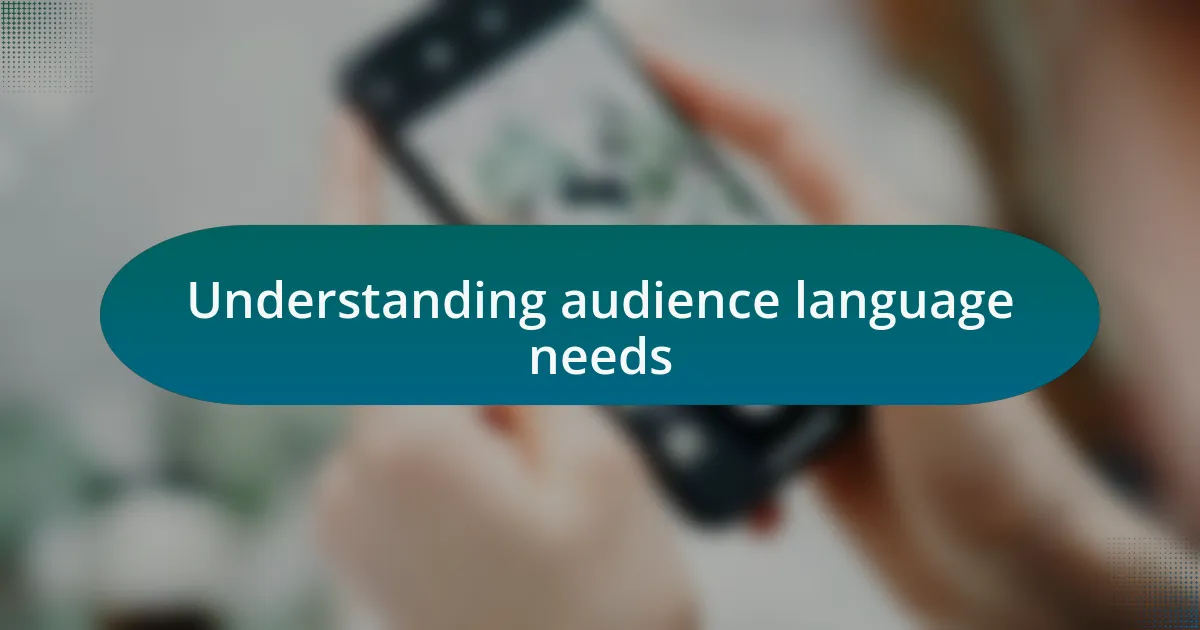
Understanding audience language needs
Understanding the language needs of your audience is crucial for effective communication. In one workshop I conducted with a diverse group of tech enthusiasts, the language barrier was more about technical jargon than ability. I realized that what’s clear to a seasoned developer might be foreign to a marketing professional, and this epiphany reshaped how I approached my sessions.
When I’m preparing for a workshop, I like to visualize the participants. Are they mostly beginners or experts? This mental image influences my terminology choices right from the start. I often ask myself, “How can I phrase this concept so everyone feels included?” It’s not just about simplifying; it’s about connecting. After all, the feeling of being understood fosters a more collaborative environment.
I remember a moment in a recent workshop when I explained a complex API in layman’s terms, and I could see the lightbulb moments. People leaned in, nodding, as if they were finally part of the conversation. That kind of connection is invaluable. It reminds me of the importance of continually assessing my audience’s comfort level with the language I use. Every word matters, and meeting them where they are creates a more engaging experience.
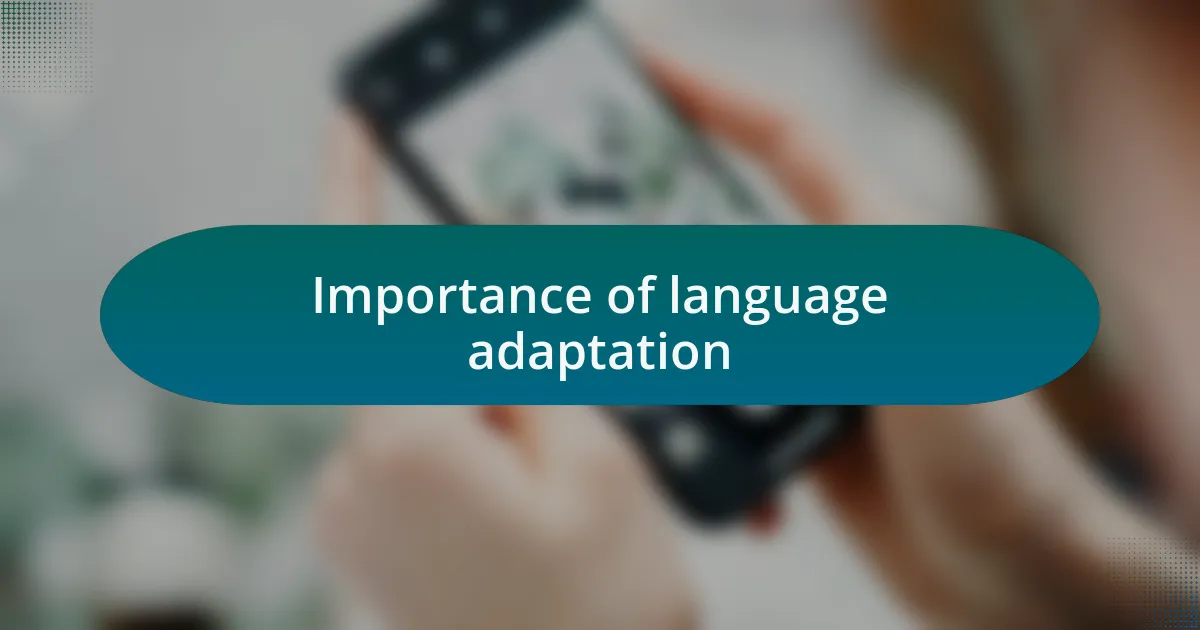
Importance of language adaptation
Adapting language effectively can transform a workshop dynamic. I remember a time when I tailored my vocabulary for a group that included not just tech professionals, but also educators and students. As I switched my phrasing from technical specifics to relatable examples, I noticed participants smiling and engaging more openly. It struck me that language isn’t just a tool for information; it’s a bridge that connects diverse backgrounds.
Using the right language can create a welcoming atmosphere where everyone feels valued. In one session, I attempted a hands-on activity using accessible vernacular, avoiding complex terms that might alienate some participants. The result? Active participation! The excitement was palpable as individuals who usually submit ideas hesitantly began to share boldly. It made me realize that by prioritizing language adaptation, I wasn’t just teaching; I was cultivating a sense of community.
Have you ever walked away from a conversation feeling excluded? That’s what I aim to avoid in my workshops. When I consciously adjust my language, I find that participants express gratitude for making complicated ideas approachable. Their engagement highlights the true power of language adaptation; it not only enriches the learning experience but also fosters genuine connections among participants.
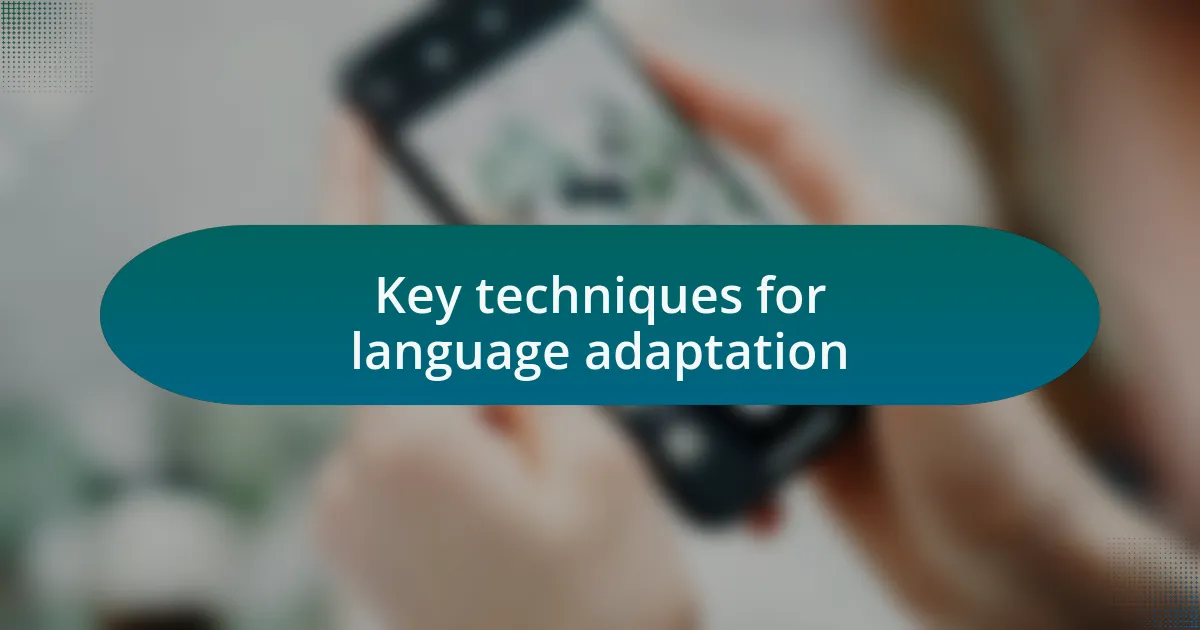
Key techniques for language adaptation
One key technique that I find invaluable is gauging the audience’s prior knowledge. During a recent workshop, I asked a few informal questions at the beginning to assess how familiar participants were with certain concepts. This simple step allowed me to adjust my language on the fly, ensuring I explained terms and ideas without making anyone feel lost or overwhelmed. It’s incredible how a few initial questions can shape the entire session.
Another effective strategy is using analogies that resonate with my audience’s experiences. In a meeting with software developers, comparing a coding process to creating a recipe worked wonders. I could see their eyes light up, as they connected familiar cooking terms with the complexities of coding. Such relatable comparisons not only clarify concepts but also make the learning process enjoyable and engaging.
Finally, I often emphasize active listening throughout my workshops. By actively tuning into participants’ reactions and questions, I can adapt my language in real time. I remember one session where a participant seemed puzzled after I introduced a new term. By slowing down and rephrasing my explanation, I not only addressed their confusion, but I also encouraged others to seek clarification. Isn’t it amazing how responsive communication can make a challenging topic feel more accessible?
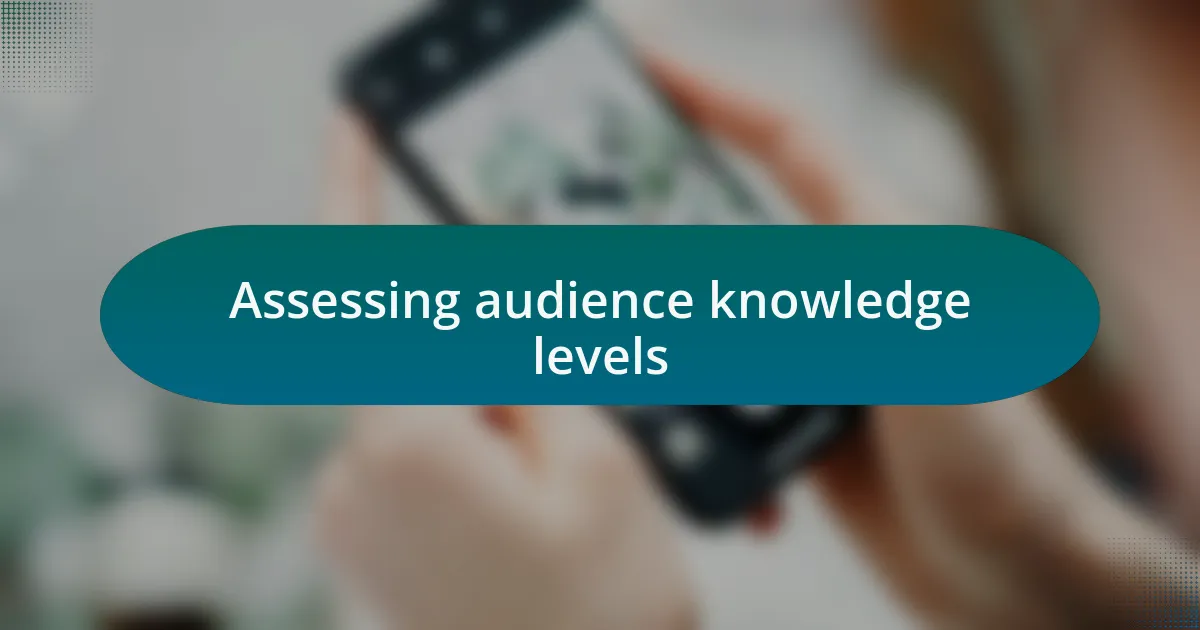
Assessing audience knowledge levels
When I start a workshop, I pay close attention to the room’s vibe. For instance, I’ve had moments where the energy felt deferential; participants were reluctant to speak up. In one particular session, I noticed a group of senior engineers who seemed hesitant to ask questions. I quickly adjusted my approach, introducing more engaging prompts that invited their input. This not only helped clarify their knowledge but also transformed the interaction from a passive one to a vibrant discussion. Have you ever experienced that shift? It’s quite powerful.
Another tactic I employ is observing non-verbal cues. During my sessions, I often scan the audience for body language — crossed arms might indicate skepticism, while leaning forward suggests interest. I recall a time when I noticed a participant furrowing his brow as I dove into technical jargon. By pausing, I could rephrase my explanation using simpler language, allowing him to relax and engage again. It’s fascinating how much information we can gather from just seeing people’s reactions.
I also make it a habit to create a brief “knowledge check” during the introduction. I sometimes use a simple poll or quick show of hands to gauge understanding. In a recent workshop focused on data science, I asked who had prior experience with machine learning. Seeing a mix of hands lifted and held down not only dictated how I presented the material but reassured less experienced attendees that they were still welcome. Isn’t it interesting how these small adjustments can create a more inclusive atmosphere?
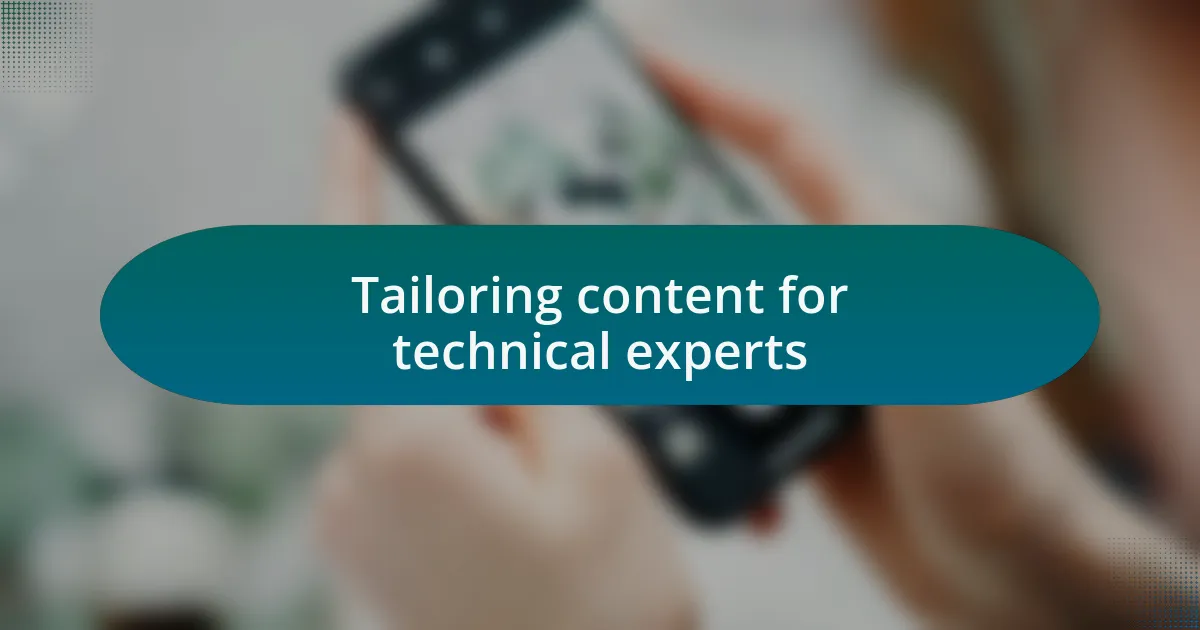
Tailoring content for technical experts
When tailoring content for technical experts, I focus on depth and relevance. I remember a workshop on cloud architecture where I was met with a sea of nodding heads. It felt empowering to share advanced concepts without holding back. To foster this expertise, I peppered my presentation with real-world examples, diving deep into case studies that these professionals found relatable. Is there anything more gratifying than seeing professionals light up at familiar scenarios?
Another key strategy is to encourage collaboration among participants. During a session on cybersecurity, I organized small group discussions, prompting experts to brainstorm solutions for current challenges. The room buzzed with excitement as they dissected trends and exchanged insights. I often wonder—how can we harness collective knowledge better? It seems that empowering them to share their experiences not only enriched the session but also built a sense of community among peers.
Finally, I find that leveraging specific terminology enhances credibility. In one workshop, I used industry-specific jargon while explaining APIs and microservices, instantly capturing the audience’s attention. Yet, I always remain mindful to clarify concepts on the fly when I sense confusion. It’s a delicate balance, and I often ask myself—how much technical detail is too much? Ultimately, ensuring clarity while delving into complex subjects is vital for effective communication with technical experts.
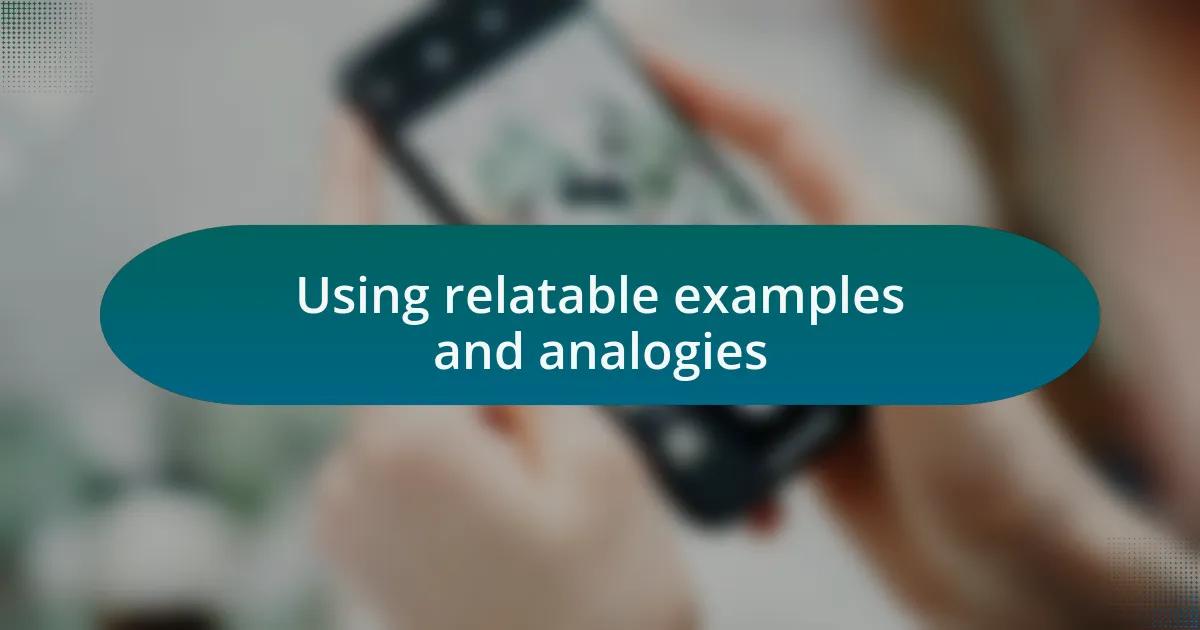
Using relatable examples and analogies
Using relatable examples and analogies can bridge the gap between complex concepts and the audience’s understanding. I recall a time when I explained data encryption by likening it to sending a locked briefcase through the postal service. This analogy not only made the concept accessible but also evoked a sense of familiarity that sparked interest across the room. It’s fascinating how a simple comparison can illuminate a topic that might otherwise feel intimidating.
When I integrate analogies, I aim to reflect my audience’s experiences, making the material more engaging. For instance, during a session on agile methodologies, I compared the iterative process to baking a cake—tasting and adjusting the recipe after each layer. In that moment, I saw expressions of recognition on participants’ faces; they connected their personal experiences to the content. Isn’t it rewarding when dialogue flows naturally because someone can relate to an idea?
I’ve also found that anecdotes, maybe from my own career, resonate well with attendees. Sharing a story about a project where miscommunication led to significant delays felt relatable and often prompted laughter. It softened the atmosphere and invited open discussion on similar experiences, emphasizing the lesson learned. Have you ever noticed how stories can transform a workshop from a monologue into a dialogue? They foster connection and often unveil shared challenges, making the learning experience far richer.
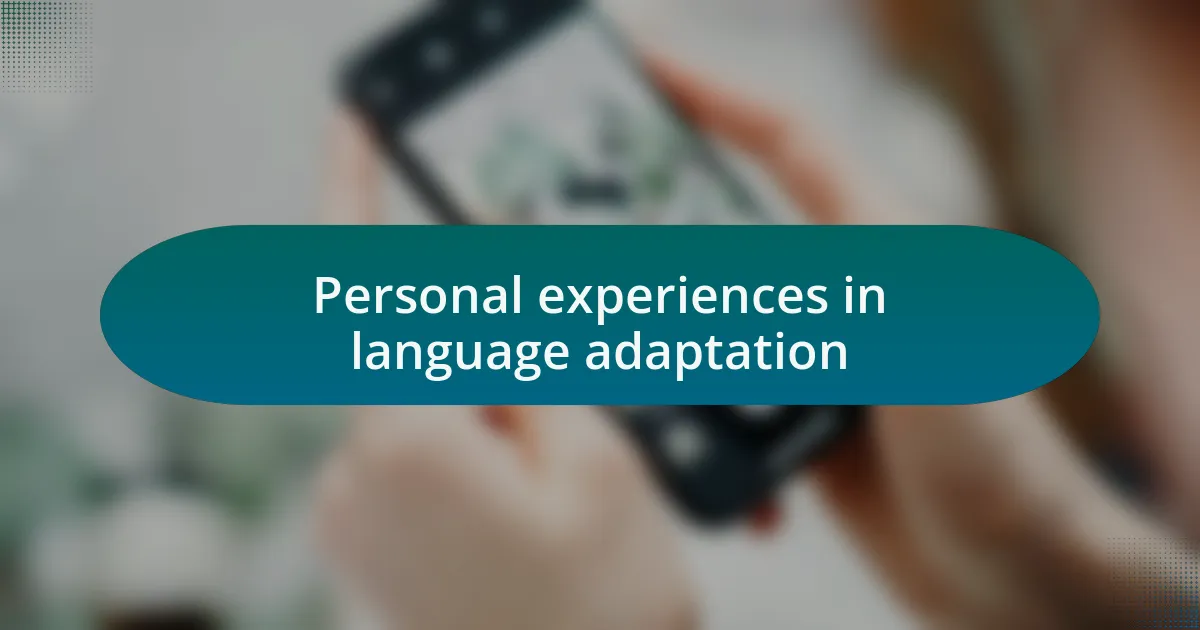
Personal experiences in language adaptation
I’ve had moments where I needed to switch gears quickly, especially when I was explaining a technical topic to a group of non-technical stakeholders. During one workshop, I used the metaphor of a traffic light to illustrate how algorithms prioritize data. I saw a shift in the audience’s body language—they were more relaxed and engaged. It’s fascinating how a small tweak in language can create such a significant impact.
In another instance, I facilitated a workshop for recent graduates and found myself adjusting my tone to match their enthusiasm while introducing advanced networking concepts. I recalled my early days when I felt overwhelmed by jargon and aimed to create an inviting space. By sharing my own initial struggles, I noticed participants leaning in, eager to grasp the subject. Have you ever felt connection through vulnerability? It’s like opening a door that allows others to step in with their own experiences.
Moreover, tailoring my language doesn’t just mean simplifying terms; it also involves infusing energy and relatability into my delivery. One time, I animatedly described cloud computing as “renting a digital room rather than buying the whole house.” The visuals it created sparked laughter and eased tensions over what could have been a dry topic. Can you remember a moment when a lighthearted analogy shifted your perspective? It’s incredible how such adaptations can transform the learning environment from intimidating to inviting.